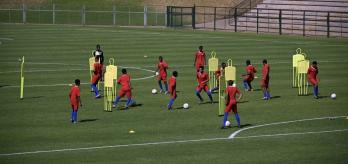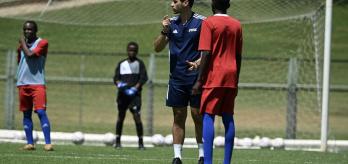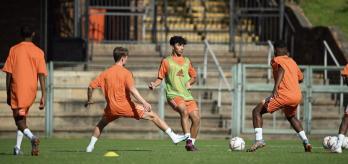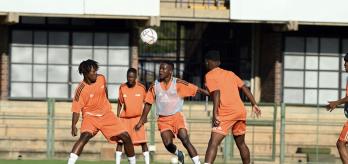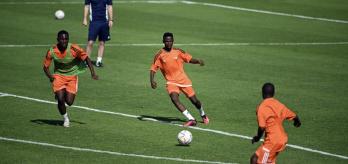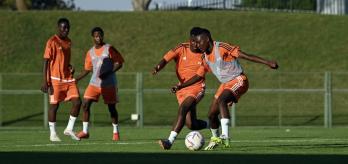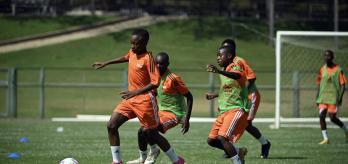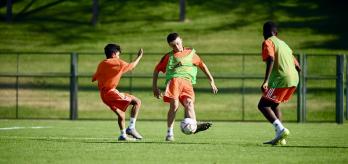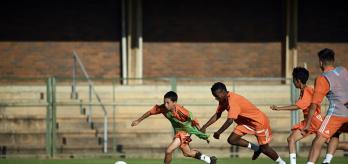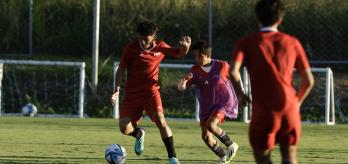Methodology
The intention: What is practised?
The main objective of this small-sided exercise is to enhance a unit’s ability to build and progress play within a narrow focus. There are other aspects, such as securing possession, that do not feature in this particular exercise. The drill focuses on breaking through the first line of defence (or in this case, the front two pressing players) and playing through the central channel as a unit. When building and progressing play, the unit is tasked with making collective decisions on whether to play through or around the press, depending on the available options. Players are encouraged to adopt an open body shape and time their movement to receive the ball, with a view to allowing them to progress play effectively.
The scale: For whom is this relevant?
The drill revolves around the unit, with a particular focus on the players’ coordination as a unit when playing out from the back. The exercise is particularly relevant to the players involved in the initial stages of the build-up, such as the goalkeeper, two centre-backs, the defensive midfielder or deep-lying midfielder (number 6) and a centre-midfielder (number 8) when up against two high-pressing forwards and a mid-block. A typical build-up involves the goalkeeper or one of the centre-backs playing the ball to the number 6 or 8, who is tasked with identifying the right moment to drop to receive so as to evade the second line of the press and play the ball into a forward (number 7, 10 or 11).
The practice type: How is the practice designed?
The drill involves an opposed, small-sided game, featuring variable repetition that provides ample opportunities for a unit to practise coordinated passing, offering to receive and receiving the ball to progress play through the thirds. The formations and zones involved in the set-up give the unit a base to build from and help the players to understand the coordination and structure required to break through a press effectively. Pitting two centre-backs up against two pressing forwards means that the defenders have fewer options and less space to break through the press, which means that they are required to execute their actions with a high level of accuracy. Once the attacking team break the first line of press, the presence of the neutral player gives them a numerical advantage. A variation is introduced that sees the offside line moved to encourage the defending team to stay higher up the pitch and squeeze play. The exercise is position-specific, with players occupying the same position and roles, although midfielders are able to break into attack.
Session plan
Organisation
-
Use half of a full-size pitch.
-
Mark out a halfway line with cones and divide the exercise area into thirds.
-
Place a full-size goal at either end of the exercise area.
-
Position a goalkeeper in either goal.
-
Set up a 4v4+1 inside the exercise area, with the attacking team arranged in a 2-1-1 formation and the defending team organised in a 1-1-2 system. The neutral player plays for the in-possession team and operates in the middle third.
Explanation
-
Play begins with one of the goalkeepers in possession.
-
The goalkeeper plays a pass to an orange player positioned in the first third or to the neutral player in the middle third.
-
The orange team’s objective is to progress the ball through the thirds and score in the opposite goal.
-
The blue team press from the front and try to win the ball and score in the opposite goal.
-
Each time a goal is scored, play restarts with the team that scored in possession.
Variation 1
-
Reduce the width of the exercise area by 3 metres to increase the focus on playing in central areas.
-
Introduce offside lines, which are marked by the end lines of the middle third.
Variation 2
-
Make the halfway line the offside line.
-
All members of the in-possession team have to be inside the opposition’s half for a goal to count.
Key coaching points
Roles of coaches
-
First coach: leads the exercise and intervenes on a number of occasions to introduce variations or to help players to perform their actions more efficiently.
-
Second coach: offers players support and encouragement from their position at the side of the exercise area and, when required, plays the ball to the goalkeepers to restart play.




























